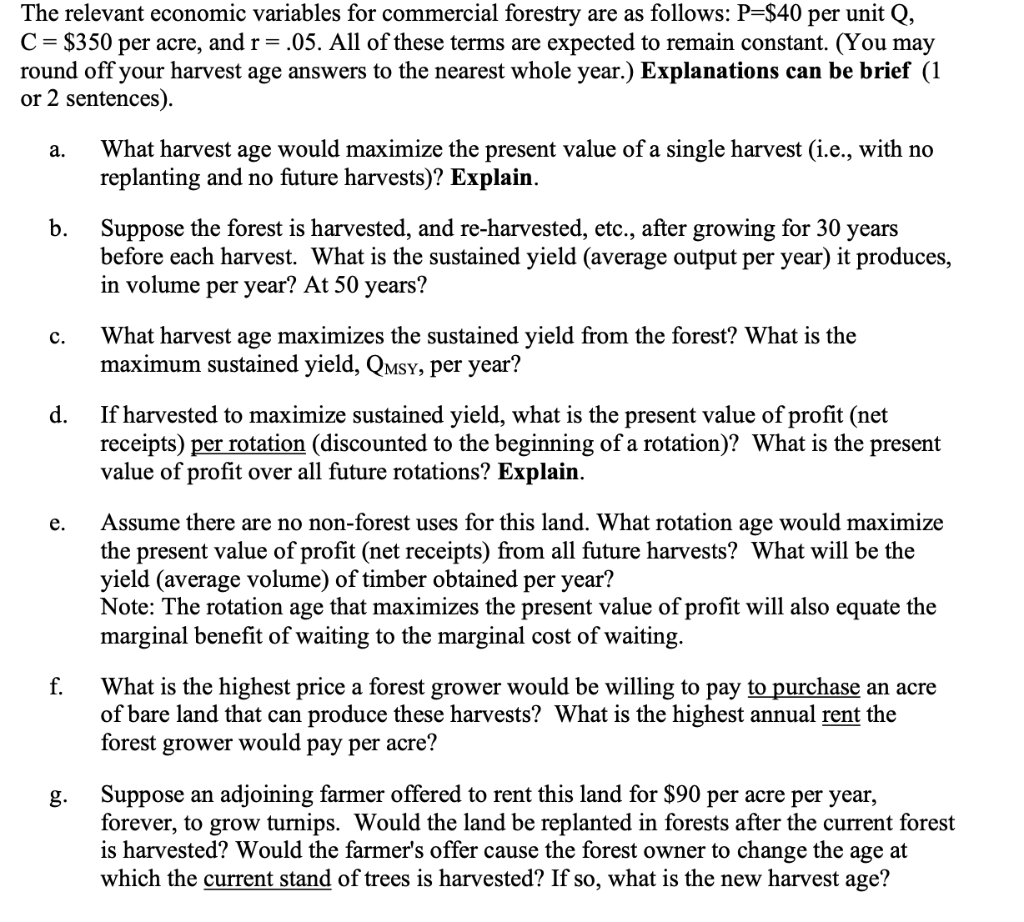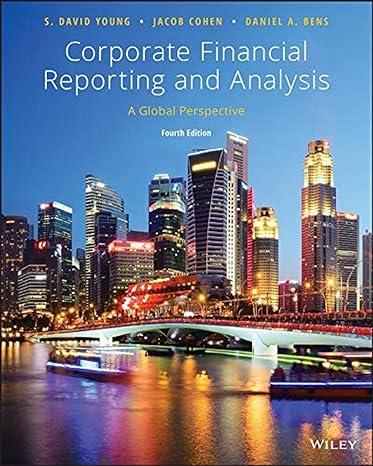

 Complete all parts to question 2 using the above information and referenced chart. Thanks
Complete all parts to question 2 using the above information and referenced chart. Thanks
2. The growth for Ponderosa pine is described in the following table. Q is the volume of timber per acre at the age shown in the first column. AQ is the annual growth. For this problem, create a spreadsheet with the forest data. Add some extra columns to help you work out the solution. Try placing rQ at the head of one new column and Q/T at the head of the second, and fill in blanks as necessary to answer parts a- c. A similar procedure will enable you to answer parts d-f, but you will need to figure out what items to place in the remaining columns. age 20 21 22 23 24 25 26 27 28 29 30 31 32 33 34 35 36 37 38 39 40 41 Q(T) 33.20 46.70 60.48 74.48 88.69 103.07 117.57 132.18 146.85 161.56 176.26 190.92 205.51 220.00 234.35 248.52 262.49 276.22 289.67 302.81 315.61 328.03 AQ(T) 13.2 13.5 13.8 14.0 14.2 14.4 14.5 14.6 14.7 14.7 14.7 14.7 14.6 14.5 14.3 14.2 14.0 13.7 13.5 13.1 12.8 12.4 42 43 44 45 46 47 48 49 50 51 52 53 54 55 56 57 58 340.05 351.61 362.70 373.28 383.30 392.75 401.58 409.77 417.27 424.05 430.08 435.33 439.76 443.33 446.02 447.79 448.60 448.42 447.22 12.0 11.6 11.1 10.6 10.0 9.4 8.8 8.2 7.5 6.8 6.0 5.2 4.4 3.6 2.7 1.8 0.8 -0.2 -1.2 59 60 The relevant economic variables for commercial forestry are as follows: P=$40 per unit Q, C = $350 per acre, and r= .05. All of these terms are expected to remain constant. (You may round off your harvest age answers to the nearest whole year.) Explanations can be brief (1 or 2 sentences). a. What harvest age would maximize the present value of a single harvest (i.e., with no replanting and no future harvests)? Explain. b. Suppose the forest is harvested, and re-harvested, etc., after growing for 30 years before each harvest. What is the sustained yield (average output per year) it produces, in volume per year? At 50 years? What harvest age maximizes the sustained yield from the forest? What is the maximum sustained yield, Qusy, per year? c. d. If harvested to maximize sustained yield, what is the present value of profit (net receipts) per rotation (discounted to the beginning of a rotation)? What is the present value of profit over all future rotations? Explain. e. Assume there are no non-forest uses for this land. What rotation age would maximize the present value of profit (net receipts) from all future harvests? What will be the yield (average volume) of timber obtained per year? Note: The rotation age that maximizes the present value of profit will also equate the marginal benefit of waiting to the marginal cost of waiting. f. What is the highest price a forest grower would be willing to pay to purchase an acre of bare land that can produce these harvests? What is the highest annual rent the forest grower would pay per acre? g. Suppose an adjoining farmer offered to rent this land for $90 per acre per year, forever, to grow turnips. Would the land be replanted in forests after the current forest is harvested? Would the farmer's offer cause the forest owner to change the age at which the current stand of trees is harvested? If so, what is the new harvest age? 2. The growth for Ponderosa pine is described in the following table. Q is the volume of timber per acre at the age shown in the first column. AQ is the annual growth. For this problem, create a spreadsheet with the forest data. Add some extra columns to help you work out the solution. Try placing rQ at the head of one new column and Q/T at the head of the second, and fill in blanks as necessary to answer parts a- c. A similar procedure will enable you to answer parts d-f, but you will need to figure out what items to place in the remaining columns. age 20 21 22 23 24 25 26 27 28 29 30 31 32 33 34 35 36 37 38 39 40 41 Q(T) 33.20 46.70 60.48 74.48 88.69 103.07 117.57 132.18 146.85 161.56 176.26 190.92 205.51 220.00 234.35 248.52 262.49 276.22 289.67 302.81 315.61 328.03 AQ(T) 13.2 13.5 13.8 14.0 14.2 14.4 14.5 14.6 14.7 14.7 14.7 14.7 14.6 14.5 14.3 14.2 14.0 13.7 13.5 13.1 12.8 12.4 42 43 44 45 46 47 48 49 50 51 52 53 54 55 56 57 58 340.05 351.61 362.70 373.28 383.30 392.75 401.58 409.77 417.27 424.05 430.08 435.33 439.76 443.33 446.02 447.79 448.60 448.42 447.22 12.0 11.6 11.1 10.6 10.0 9.4 8.8 8.2 7.5 6.8 6.0 5.2 4.4 3.6 2.7 1.8 0.8 -0.2 -1.2 59 60 The relevant economic variables for commercial forestry are as follows: P=$40 per unit Q, C = $350 per acre, and r= .05. All of these terms are expected to remain constant. (You may round off your harvest age answers to the nearest whole year.) Explanations can be brief (1 or 2 sentences). a. What harvest age would maximize the present value of a single harvest (i.e., with no replanting and no future harvests)? Explain. b. Suppose the forest is harvested, and re-harvested, etc., after growing for 30 years before each harvest. What is the sustained yield (average output per year) it produces, in volume per year? At 50 years? What harvest age maximizes the sustained yield from the forest? What is the maximum sustained yield, Qusy, per year? c. d. If harvested to maximize sustained yield, what is the present value of profit (net receipts) per rotation (discounted to the beginning of a rotation)? What is the present value of profit over all future rotations? Explain. e. Assume there are no non-forest uses for this land. What rotation age would maximize the present value of profit (net receipts) from all future harvests? What will be the yield (average volume) of timber obtained per year? Note: The rotation age that maximizes the present value of profit will also equate the marginal benefit of waiting to the marginal cost of waiting. f. What is the highest price a forest grower would be willing to pay to purchase an acre of bare land that can produce these harvests? What is the highest annual rent the forest grower would pay per acre? g. Suppose an adjoining farmer offered to rent this land for $90 per acre per year, forever, to grow turnips. Would the land be replanted in forests after the current forest is harvested? Would the farmer's offer cause the forest owner to change the age at which the current stand of trees is harvested? If so, what is the new harvest age


 Complete all parts to question 2 using the above information and referenced chart. Thanks
Complete all parts to question 2 using the above information and referenced chart. Thanks





